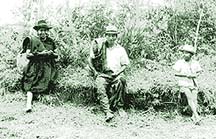
![]()
 The forced
displacement of persons, an element of the armed conflict affecting poor
peasant communities, is one of the most serious Human Rights violations,
and has contributed substantially to the critical situation confronting
the country. The creation of a culture of respect for Human Rights and International
Humanitarian Law, determined action on the part of the Colombian state and
society, and a negotiated solution to the conflict, shall allow the problem
of displacement to be stabilized and resolved. The forced
displacement of persons, an element of the armed conflict affecting poor
peasant communities, is one of the most serious Human Rights violations,
and has contributed substantially to the critical situation confronting
the country. The creation of a culture of respect for Human Rights and International
Humanitarian Law, determined action on the part of the Colombian state and
society, and a negotiated solution to the conflict, shall allow the problem
of displacement to be stabilized and resolved.The Colombian government incorporated the characterization of forced displacement into criminal legislation through Law 589 of 2000, recently approved by Congress, and in the new Penal Code, article 159 of Law 599 of 2000. It is described as a crime against persons and property protected by International Humanitarian Law. The criminalization of forced displacement shows that a will to deal with this problem does exist. It is an instrument of protection, and an instrument for the fight against impunity concerning Human Rights violations. It is also a means to tackle the consequences of this phenomenon. In keeping with its Policy for the Promotion and Guarantee of Human Rights and the Application of International Humanitarian Law, the national government is promoting humanitarian agreements on the displaced population. Also, the government supports the initiatives that emerge in the framework of the peace agenda, including the Permanent Assembly of Civil Society for the protection of the civilian population. A comprehensive policy on assistance to the displaced population is set down in CONPES Document 3057 of 1999. It introduces a Plan of Action for the Prevention and Attention to Forced Displacement, which, aimed at developing an effective institutional scheme, ensures the commitment of the territorial authorities, defines the responsibilities and duties of the agencies that make up the national assistance system, and displaces the assistance-only approach. The document defines mechanisms for the prevention of displacement, and for the protection, humanitarian assistance, return, resettlement, and socioeconomic stabilization of the population displaced by violence. In addition, it lays out a National System of Integral Attention to the Displaced Population, and entrusts coordination to the Social Solidarity Network, with the participation of government offices, non-governmental organizations and multilateral agencies. It also creates a Joint Technical Unit, in which the Office of the United Nations High Commissioner for Refugees -UNHCR, takes part. The United Nations Guiding Principles on Internal Displacement, which provide a reference point to governments, authorities and individuals, are the framework for the current policy on assistance to the displaced population. These principles reflect the views of Mr. Francis Deng, Representative of the United Nations Secretary-General, who visited Colombia three times. Law 387 of 1997 adopted measures for the prevention of forced displacement, and for the assistance, protection and socioeconomic consolidation and stabilization of persons internally displaced by violence. Appropriate procedures have been established ever since, ensuring that the Colombian State provides more efficient services. Constitutional Court Ruling 1150 regarding forced displacement, issued last August, underlined the urgency to develop new legislation, and the need to regard population displacement as a social emergency and improve coordination between the Colombian society, non-governmental organizations and the international community. The aims of the policy on assistance to the displaced include the following: developing mechanisms for preventing displacement; creating conditions appropriate for an integral, sustainable development; strengthening social organizations, particularly those formed by displaced persons; promoting humanitarian spaces in conflict zones; extending humanitarian assistance schemes; promoting the voluntary return of displaced communities. Efforts are being made to forge effective partnerships with the private sector, non-governmental organizations and the international community, in connection with assistance and the prevention of forced displacement, the promotion and funding of community business schemes, and the development of mechanisms to regulate land tenure in places of origin and resettlement. Action taken by the National System of Integral Attention to the Displaced Population, with the coordination of the Social Solidarity Network, include the consolidation of an information system, programs of protection, prevention and humanitarian assistance in food and non-food aid, and the provision of temporary assistance; resettlement programs, including housing and business projects with financial support through credit, long-term aid schemes, and return programs. Despite the significant progress made in the implementation of the policy, the government is aware that substantial inadequacies are still to be seen in the assistance provided to the displaced population, partly for fiscal reasons, and partly because of the logic of the armed conflict and the socioeconomic dynamics generated by the displacement itself. |